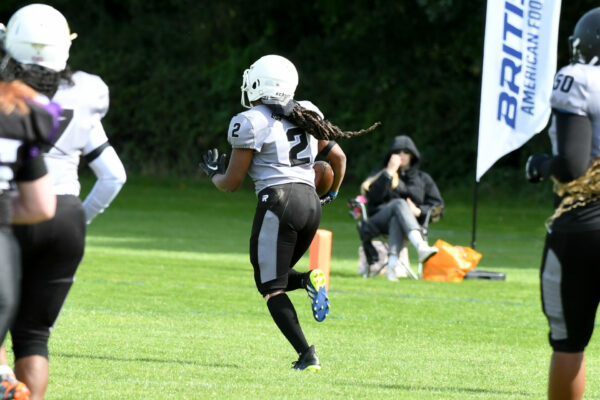Following the conclusion of the 2022 NWFL season, with the London Warriors and Edinburgh Wolves claiming respective Premiership and Division One titles, the Strategic Lead for Women’s football Arran Harrison has outlined his strategy to the league.
Working alongside NWFL Competition Manager Mathew Micklethwaite, Harrison has defined a league strategy founded on stability, integrity and communication.
Competition Pyramid
In his strategy, Harrison detailed the Competition Pyramid upon which the strategy is based.
“Following the recent success of the National Programme at the World Championship, we all now have a responsibility to create a legacy that will push women’s American football in Great Britain to the forefront of Britball and beyond. Our goal must be to create the best women’s domestic league in Europe by proving a competition structure that makes American football accessible to all no matter of their age, their ability, or their standard.
To achieve this, we will need to create a competition structure that allows players and coaches the opportunity to develop and progress their football career to a high standard at the full sided game should they chose to do so. Equally, we need to provide a tier that allows fledgling clubs to develop and grow. Finally, we should be looking at where our next superstars are going to come from by making female football accessible from an early age. As a result, I will be looking at implementing a competition structure that will facilitate a full competition pathway that will provide multiple tiers of competition standards and in line with the BAFA 10-year vision.”

Foundation Tier
At the base of the Competition Pyramid is the Foundation Tier:
“Whilst this will not be a short-term objective, it is worth highlighting this initiative as part of the future vision for women’s football. Any successful programme will know that the key to development of talent and creating the stars of tomorrow is by having a successful youth programme. Right now, we can only develop young females in our sport through the current mixed youth formats that we have in place, however, the long-term strategy is to look at ways in which we can provide a competition for female only youth programs.”
Participation Tier
The NWFL as it currently operates today serves as the Participation Tier within the pyramid:
“We are all aware that whilst the 7 a side format is a great entry/development level for clubs, it does not fulfil the needs of the clubs, players, and coaches who wish to develop themselves further and compete at a higher level. For the National programme to achieve what they achieved at the worlds this summer is nothing short of astounding considering our domestic product remains at the 7-a-side format.
As with last year, nine-a-side will again be put on the table for those wish to do so. Nines is not a given, we will need a minimum of four teams with sustainable numbers to move to nines to ensure competition sustainability and integrity. This would provide a minimum of three home and three away games with full special teams. Should nines go ahead, given the expected small number of teams able to achieve this format, it is envisaged that this will need to be a national league where travel will be required for participating teams.
Sevens will remain in place for those clubs who cannot move to nines just yet, or, for fledgling clubs to develop and ready themselves for nines football in the future. This will be put into regional conferences to minimise travel and to support the development of the sport in that region. This will also allow stability to the alignments, rather than have to change them each year depending on who is promoted and who is relegated.”
Performance Tier
The Performance Tier is to be the highest level of domestic competition in Women’s football:
“What is an absolute must is having 11 a side football back in the calendar. Due to Covid, Super Elevens (formerly Diamond) had to be removed from the calendar and now there is nothing stopping us from bringing this back. Super Elevens will be re-introduced into the competition structure as a performance tier with the chance for players, coaches, and club managers who wish to perform at a high domestic level to do so. A full rebrand of the competition will be initiated and, from the recent feedback received from players, coaches, and clubs, there appears a significant appetite for this where we could create three new 11 a side teams (North, Central, South) to compete in a 3-game series.
The clubs will be expected to be run at a high standard where the best female athletes can compete against each other. There will be expectations that these Super Elevens clubs support the development of the NWFL clubs within their region, but also be of a standard that bridges the gap between the NWFL and the National Programme. Clearly this will be a massive undertaking and we will be looking to put together a group of people involved in the women’s game to support the development and implementation of this competition.”








